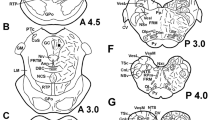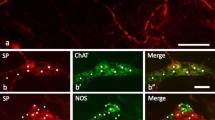Summary
1. The distribution and microvascular effects of substance P (SP) and calcitonin gene-related peptide (CGRP) were studied in the rabbit tenuissimus muscle using immunohistochemistry and intravital microscopy. 2. Individual fibers within nerve bundles and along blood vessels in the muscle were found to be immunoreactive (IR) for both SP and CGRP, thus showing an apparently complete coexistence for these peptides. In dorsal root ganglia most SP-positive cells were also CGRP-IR, but the latter cells were somewhat more numerous than SP-IR cells. 3. When applied topically to the muscle, both SP and CGRP increased blood flow in a dose-dependent manner, but CGRP was more potent and caused responses of longer duration. Both SP and CGRP dilated transverse arterioles, but they had little or no effect on the smaller terminal arterioles. This resulted in a redistribution of blood flow to the connective tissue adjacent to the muscle. 4. SP, but not CGRP, elicited vigorous vasomotion in larger arterioles and caused the formation of aggregates of platelets and leukocytes in the venules. Neither flow increase, nor vasomotion or aggregate formation were influenced by pretreatment of the animals with mepyramine, cimetidine or indomethacin. Capsaicin (1 μM) had a powerful effect on transverse arterioles resembling that of both SP and CGRP. 5. It is concluded that some of the vascular effects hitherto ascribed to SP on the basis of nerve stimulation and application of capsaicin might, at least in part, be due to release of CGRP.
Similar content being viewed by others
References
Amara SG, Jonas V, Rosenfeld MG, Ong ES, Evans RM (1982) Alternative RNA processing in calcitonin gene expression generates mRNAs encoding different polypeptide products. Nature 298:240–244
Brain SD, Williams TJ, Tippins JR, Morris HR, MacIntyre 1 (1985) Calcitonin gene-related peptide is a potent vasodilator. Nature 313:54–56
Burcher E, Atterhög J-H, Pernow B, Rosell S (1977) Cardiovascular effects of substance P: Effects on the heart and regional blood flow in the dog. In: von Euler US, Pernow B (eds) Substance P. Raven Press New York, pp 261–268
Cuello AC, Galfre G, Milstein C (1979) Detection of substance P in the central nervous system by a monoclonal antibody. Proc Natl Acad Sci USA 76:3532–3536
Dalsgaard C-J, Hægerstrand A, Theodorsson-Norheim E, Brodin E, Hökfelt T (1985) Neurokinin A-like immunoreactivity in rat primary sensory neurons; coexistence with substance P. Histochemistry 83:37–39
Eklund B, Jogestrand T, Pernow B (1980)Effect of substance P on resistance and capacitance vessels in the human forearm. In: von Euler US, Pernow B (eds) Substance P. Raven Press, New York, pp 261–268
Faber JE, Harris PD, Miller FN (1982) Microvascular sensitivity to PGE2 and PG12 in skeletal muscle of decerebrate rat. Am J Physiol 243: H844-H851
Foreman JC, Jordan CC, Oehme P, Renner H (1983) Structureactivity relationships for some substance P-related peptides that cause wheal and flare reactions in human skin. J Physiol 335:449–465
Gibbins IL, Furness JB, Costa M, MacIntyre I, Hillyard CJ, Girgis S (1985) Co-localization of calcitonin gene-related peptide-like immunoreactivity with substance P in cutaneous, vascular and visceral sensory neurons of guinea pigs. Neurosci Lett 57:125–130
Gibson SJ, Polak JM, Bloom SR, Sabate IM, Mulderry PM, Ghatei MA, McGregor GP, Morrison JFB, Kelly JS, Evans RM, Rosenfeld MG (1984) Calcitonin gene-related peptide immunoreactivity in the spinal cord of man and of eight other species. Neuroscience 4:3101–3111
Hägermark O, Hökfelt T, Pernow B (1978) Flare and itch induced by substance P in human skin. J Invest Dermatol 71:233–235
Johnson DG, de C Nogueira Araujo GM (1981) A simple method of reducing the fading of immunofluorescence during microscopy. J Immunol Meth 43:349
Ju G, Hökfelt T, Brodin E, Fahrenkrug J, Fischer JA, Frey P, Elde RP, Brown JC (1987) Primary sensory neurons in rat showing calcitonin gene-related peptide (CGRP)-immunoreactivity and their relation to substance P-, somatostatin-, galanin-, vasoactive intestinal polypeptide- and cholecystokinin- immunoreactive cells. Cell Tiss Res 247:417–431
Kanagawa K, Minamoto N, Fukuda A, Hisayuki M (1983) Neuromedin K: a novel mammalian tachykinin identified in porcine spinal cord. Biochem Biophys Res Commun 111: 533–540
Kimura S, Okada M, Sugita Y, Kanazawa I, Munekata E (1983) Novel neuropeptides, neurokinin a and P isolated from porcine spinal cord. Proc Jap Acad Sci 59:101–104
Lee Y, Takami K, Girgis S, Hillyard CJ, MacIntyre I, Emson PC, Tohyama M (1985) Distribution of calcitonin gene-related peptide in the rat peripheral nervous system with reference to its coexistence with substance P. Neuroscience 15:1227–1237
Lembeck F, Holzer P (1979) Substance P as neurogenic mediator of antidromic vasodilation and neurogenic plasma extravasation. Naunyn-Schmiedeberg's Arch Pharmacol 310:175–183
Lembeck F (1983) Sir Thomas Lewis's nocifensor system, histamine and substance-P-containing primary afferent nerves. Trends Neurosci 6:106–108
Levine JD, Clark R, Devor M, Helms C, Moskowitz MA, Basbaum AI (1984) Intraneuronal substance P contributes to the severity of experimental arthritis. Science 226:547–549
Lindbom L, Tuma RF, Arfors K-E (1982) Blood flow in the rabbit tenuissimus muscle. Influence of preparative procedures for intravital microscopic observations. Acta Physiol Scand 114:121–127
Lindbom L, Arfors K-E (1984a) The tenuissimus muscle preparation as a model for intravital microscopic studies of skeletal muscle circulatory function. Prog Appl Microcirc 6:32–40
Lindbom L, Arfors K-E (1984b) Non-homogeneous blood flow distribution in the rabbit tenuissimus muscle; Differential control of total blood flow and capillary perfusion. Acta Physiol Scand 122:225–233
Minamino N, Kanagawa K, Fukuda A, Mabue H (1984) Neuromedin L: A novel mammalian tachykinin identified in porcine spinal cord. Neuropeptides 4:157–166
Nawa H, Hirose T, Takashima H, Inayama S, Nakanishi S (1983) Nucleotide sequence of cloned cDNAs for two types of bovine brain substance P precursor. Nature 306:32–36
Nilsson J, von Euler AM, Dalsgaard C-J (1985) Stimulation of connective tissue cell growth by substance P and substance K. Nature 315:61–63
Payan DG, Brewster DR, Goetzl GJ (1983) Specific stimulation of human T lymphocytes by substance P. J Immunol 131:1613–1615
Pernow B, Rosell S (1975) Effect of substance P on blood flow in canine adipose tissue and skeletal muscle. Acta Physiol Scand 93:139–141
Pemow B (1983) Substance P. Pharmacol Rev 35:86–141
Platt JL, Michael AF (1983) Retardation of fading and enhancement of intensity of immunofluorescence by p-phenylenediamine. J Histochem Cytochem 31:840–842
Rosenfeld MG, Mermod JJ, Amara SG, Swanson LW, Sawchenko PE, Rivier J, Vale WW, Evans RH (1983) Production of a novel neuropeptide encoded by the calcitonin gene via tissue specific RNA processing. Nature 304:129–135
Tschopp FA, Tobler PH, Fischer JA (1984) Calcitonin gene-related peptide in the human thyroid, pituitary and brain. Mol Cell Endocrinol 36:53–57
Wayland H, Johnson PC (1967) Erythrocyte velocity measurement in microvessels by a two-slit photometric method. J Appl Physiol 22:333–337
Zamboni L, DeMartino C (1967) Buffered picric-acid formaldehyde: a new rapid fixative for electron-microscopy. J Cell Biol 35:148A
Author information
Authors and Affiliations
Additional information
Send offprint requests to: A. Ohlen, Department of Physiology, Karolinska Institutet, S-104 01 Stockholm, Sweden
Rights and permissions
About this article
Cite this article
Öhlen, A., Liudbom, L., Staines, W. et al. Substance P and calcitonin gene-related peptide: immunohistochemical localisation and microvascular effects in rabbit skeletal muscle. Naunyn-Schmiedeberg's Arch Pharmacol 336, 87–93 (1987). https://doi.org/10.1007/BF00177756
Received:
Accepted:
Issue Date:
DOI: https://doi.org/10.1007/BF00177756




